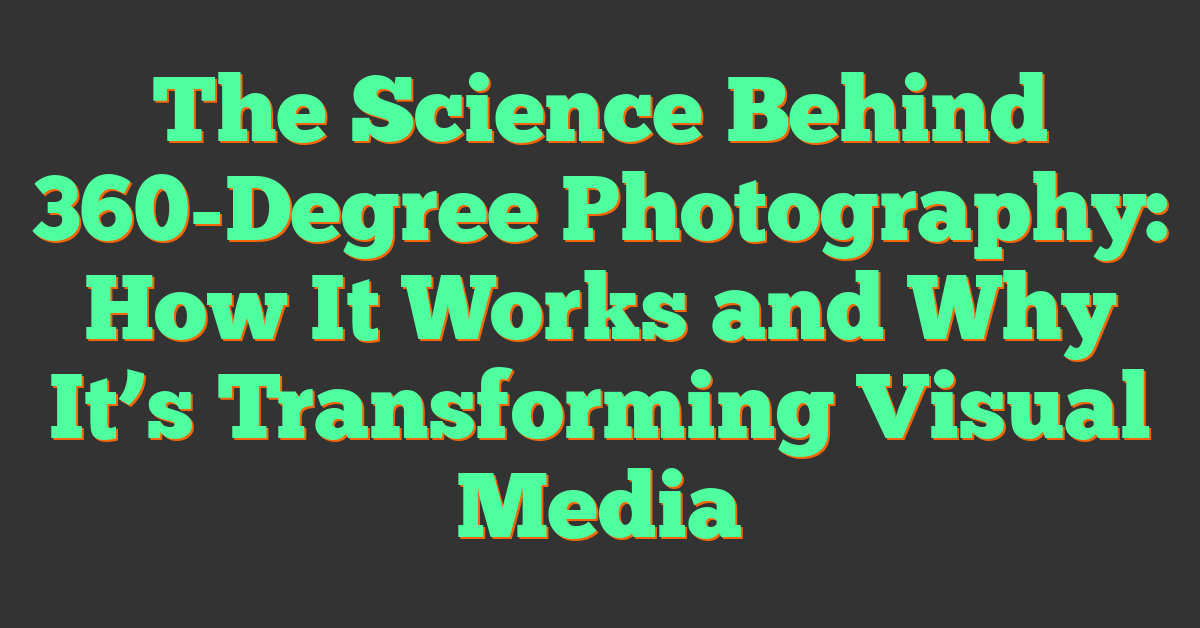Key Takeaways
- 360-degree photography provides immersive experiences by capturing scenes from every angle, creating fully interactive and spherical visuals.
- Specialized cameras and stitching software are crucial for combining overlapping images into seamless panoramic outputs, with tools like fisheye lenses and algorithms ensuring high-quality results.
- The science behind optics and image projection drives 360 imaging, relying on fisheye lenses, equirectangular mapping, and precision alignment to deliver captivating visuals.
- Applications span industries like VR, real estate, and education, offering unique storytelling opportunities through virtual tours, gaming backgrounds, and interactive training modules.
- The technology brings benefits like creative flexibility and enhanced engagement but faces challenges, including high equipment costs, complex workflows, and potential distortions.
- Future innovations such as AI-powered stitching, higher resolutions, and AR integration promise to make 360 photography more powerful, accessible, and immersive.
Capturing the world in its full, immersive glory has always fascinated me, and 360-degree photography takes this to a whole new level. Unlike traditional photos, these dynamic images let you explore every angle, creating a sense of presence that’s unmatched. But have you ever wondered how this technology actually works?
At its core, 360-degree photography blends cutting-edge optics and smart software to stitch multiple images into a seamless sphere. It’s not just about fancy cameras—it’s about the science that brings these captivating visuals to life. From lens design to image processing, there’s a lot happening behind the scenes.
In this article, I’ll break down the fascinating mechanics of 360-degree photography and show you how it’s changing the way we capture and experience the world. Whether you’re a tech enthusiast or just curious, you’re in for an eye-opening journey.
What Is 360-Degree Photography?
360-degree photography captures a scene in every direction, creating a fully immersive image. Instead of focusing on one frame or angle, these photos use a spherical perspective, giving viewers the ability to explore a scene as if they’re standing inside it.
This type of photography involves specialized cameras, including dual-lens setups, that capture wide fields of view. These lenses record overlapping visuals, and software stitches these captures together into a seamless sphere. Some examples include product shots that viewers can rotate or panoramic landscapes where every detail becomes visible.
The result is interactive content, popular in areas like real estate, tourism, and virtual reality. Unlike traditional photography, where composition centers on a single frame, 360-degree photography considers how elements appear from multiple angles, ensuring consistent balance across the sphere. Thanks to advancements in both optics and algorithms, it’s accessible to professionals and beginners alike.
How 360-Degree Photography Works
This technique captures full 360-degree spherical views by combining hardware and software elements. Cameras record overlapping visuals, and software merges them into a seamless interactive experience.
The Role Of Specialized Cameras
Specialized cameras are the core of 360-degree photography. Dual-lens fisheye cameras, like the Ricoh Theta series, use ultra-wide-angle lenses to capture fields of view close to 200 degrees per lens. Multi-camera rigs, often used for professional shots, combine several lenses to cover every angle.
Each lens records overlapping images to ensure complete coverage. The high-resolution sensors in premium 360 cameras, such as the Insta360 ONE X3, capture intricate details, creating sharp and immersive outputs. Built-in gyroscopes enhance stabilization, critical for creating smooth visuals during movement-based or handheld shooting.
Software For Stitching Images
« Why 360 Cameras Matter in a Visual World: Unlock Immersive Storytelling and Creativity
Best Night Vision 360 Cameras for Low-Light Shooting You Can’t Afford to Miss »
Software seamlessly merges individual images into a single 360-degree spherical view. In-camera solutions, found in consumer models like GoPro MAX, automatically process and stitch photos. These systems use algorithms to align overlapping areas and balance lighting for consistency.
Professional desktop tools, such as PTGui or Kolor Autopano (discontinued but still referenced), give advanced control over stitching parameters. They allow manual adjustments for misalignments, lens distortion, or exposure issues. For video, editors like Adobe Premiere Pro with third-party plugins handle stitching while enabling post-production enhancements.
Integration between camera hardware and stitching software ensures the final output is realistic and captivating, making each 360-degree image ready for sharing on platforms like YouTube VR and Facebook 360.
The Physics Of 360-Degree Imaging
Physics plays a crucial role in capturing immersive 360-degree photographs and videos. The mechanics involve optical principles, lens behaviors, and image projection methods, ensuring detailed spherical captures that mimic how we naturally perceive our surroundings.
Understanding Optics And Lenses
Lenses are the foundation of 360 photography. Most 360 cameras I’ve worked with use ultra-wide fisheye lenses, which capture fields of view exceeding 180 degrees. These lenses gather light from a broad perspective, allowing each shot to encompass a hemispherical view of the scene. Dual-lens systems, where two fisheye lenses face opposite directions, are common in consumer cameras like the Insta360 X3 and Ricoh Theta series.
The curvature of fisheye lenses ensures minimal distortion on spherical image edges, critical for stitching images seamlessly. High-quality optical components, such as those in professional rigs, improve light transmission and color accuracy, enabling better results even in low-light situations. Precision matters — the alignment between lenses determines image overlap, which directly impacts the final stitch quality.
Image Projection Techniques
Capturing spherical visuals relies on translating curved light into flat surfaces using mathematical projection. Equirectangular projection, widely used in 360 photography, maps the spherical imagery into a rectangular grid. This method ensures compatibility with platforms like YouTube VR and Adobe editing software.
Advanced projection techniques, such as cubemap projection, divide the sphere into multiple faces to retain higher image quality in virtual environments. I’ve noticed this being implemented in advanced VR production pipelines since it minimizes distortion when viewed in detail-specific applications like gaming.
The blending of multiple images into a cohesive sphere depends on overlapping image data. Overlap allows image stitching software to align shared points, avoiding visible seams. Precise projection and algorithms maximize consistency, giving end-users a flawless immersive experience.
Applications Of 360-Degree Photography
360-degree photography transforms how we capture and experience the world. Its versatile applications span various fields, offering unique storytelling opportunities for photographers and videographers.
Virtual Reality And Gaming
Immersive experiences in virtual reality (VR) and gaming heavily rely on 360-degree photography. High-quality 360 images and videos create life-like environments for VR headsets, enabling users to explore scenes as if they’re physically present. Game designers often use 360-degree visuals for lifelike backgrounds and interactive narratives, enhancing realism. As someone fascinated by VR, I find creating spherical content for gaming thrilling, as it merges creativity with technical precision.
Real Estate And Tourism
Interactive virtual tours in real estate and tourism depend on 360-degree photography. Real estate professionals use 360 captures to showcase properties, allowing buyers to explore details before visiting. In tourism, destinations leverage immersive images to highlight attractions, helping travelers visualize experiences. I’ve seen how 360 technology helps convey spatial and atmospheric features, offering unparalleled engagement. Platforms like Matterport and Kuula make it easy to share these showcases.
Education And Training
Engaging training modules and educational content benefit immensely from 360-degree photography. Fields like medical training, engineering, and safety simulations use spherical visuals to replicate real-world scenarios for learners. I’ve worked on creating 360 videos for VR training, and they deliver hands-on experiences without logistical constraints. Educational institutions often turn to this technology for virtual field trips, enabling students to explore landmarks or ecosystems remotely.
Benefits And Limitations
360-degree photography has revolutionized how we capture and share immersive content. By surrounding the viewer with a full panorama, this technology offers unparalleled storytelling capabilities but comes with certain constraints.
Advantages Of 360-Degree Photography
- Immersive Experiences
360-degree photography creates an immersive environment, letting viewers explore every angle of a scene. This is particularly effective for applications like virtual reality, where realism and engagement matter most. - Versatility Across Industries
360-degree imagery benefits sectors like tourism, real estate, and education. For example, real estate agents use virtual tours to showcase homes, while educators design interactive training environments using 360 content. Enhanced Viewer Engagement
Interactive content encourages greater exploration. Platforms supporting 360 videos, such as YouTube VR and Facebook 360, allow users to pan and zoom for a personalized viewing experience.
- Unique Creative Opportunities
This format inspires creative storytelling by capturing scenes from perspectives that traditional photography can’t replicate. For instance, immersive drone 360 shots add dynamic layers to videos.
- Compatibility With Modern Technology
360-degree cameras integrate seamlessly with editing software and sharing platforms. Tools like Adobe Premiere Pro and Insta360 Studio streamline the post-processing experience, even for beginners.
Challenges To Overcome
- High Equipment Costs
Advanced 360-degree cameras, particularly rigs used for professional-level content, are expensive. For example, multi-camera setups can cost thousands of dollars, limiting access for newcomers.
- Complex Workflow
Shooting 360 photos requires precision, as stitching errors often occur when cameras aren’t perfectly aligned. Post-production is also time-intensive when editing high-resolution spherical images.
- Limited Awareness Among Audiences
Not everyone understands how to view 360 content effectively. Ensuring users on platforms like social media know about interactive features remains a communication challenge.
- Storage and Processing Demands
High-resolution 360 imagery consumes substantial storage space and requires powerful hardware for smooth editing. A single 8K video can take up gigabytes of space quickly.
- Potential For Distortion
While fisheye lenses and stitching software reduce curvature, imperfections can still disrupt the seamlessness of the final output. For professional work, slight distortions can affect quality.
Striking a balance between leveraging 360-degree photography’s advantages and addressing its challenges enables photographers and videographers to master this fascinating medium.
Future Innovations In 360-Degree Photography
Continuous advancements are shaping the future of 360-degree photography, bringing creative opportunities for photographers and videographers like me. These innovations aim to enhance image quality, ease of use, and immersive experiences.
AI-Powered Enhancements
Artificial intelligence plays a significant role in improving 360-degree photography. Software now uses AI to automate stitching, reducing manual corrections and ensuring seamless outputs. AI-driven algorithms enhance low-light performance and dynamic range, making challenging conditions manageable. For example, some cameras employ AI to predict and fill gaps in overlapping areas, delivering sharper results.
Higher-Resolution Captures
Manufacturers are focusing on ultra-high-resolution sensors for 360 cameras. Current models already support 8K video, but future devices may integrate 12K or higher, catering to professional-level needs. This improvement enhances the overall viewing experience on VR devices by eliminating pixelation. Higher resolution allows creators to crop content without losing significant detail.
Real-Time Editing Technologies
Real-time processing and editing will redefine workflows. Emerging camera models incorporate in-device editing features, allowing creators to adjust footage instantly without external software. Live broadcasting of 360-degree content with real-time effects, transitions, and adjustments is also becoming a reality, enhancing audience engagement.
Integration With Augmented Reality (AR)
Combining 360-degree photography with augmented reality offers limitless possibilities. AR overlays enhance 360 media, providing annotations, interactive hotspots, or live updates. This integration proves useful for educational tours or guided real estate walkthroughs, creating a mixed-reality environment.
Advanced Depth Mapping
Depth detection technology is evolving for 360 cameras. Upcoming innovations include advanced LiDAR sensors that add depth data into 360 images or videos. This capability improves VR applications, especially in interactive environments, by providing realistic spatial awareness.
Improved Portability
Smaller, lighter 360 cameras with foldable or attachable designs are gaining traction. Compact models combined with robust features allow on-the-go creators to capture high-quality spherical visuals effortlessly. Innovations in battery technology and storage solutions ensure portability without compromising functionality.
Cloud-Based Ecosystems
Cloud integration streamlines sharing and collaboration. Future 360 cameras aim to incorporate automatic cloud uploads for backups or project collaboration directly from the device. Cloud-enabled platforms simplify workflows for teams working on VR content or immersive media production.
360-degree photography is set to break new grounds. Focuses on AI, resolution, and real-time abilities ensure that creators push boundaries with less effort. For passionate photographers and videographers, these innovations present exciting tools for creative exploration.
Conclusion
360-degree photography represents a remarkable fusion of technology and creativity, offering endless possibilities for capturing and sharing immersive experiences. Its ability to transform how we perceive and interact with the world is nothing short of revolutionary.
As advancements in AI, optics, and software continue, this medium is becoming more accessible and versatile than ever. Whether you’re a professional or a hobbyist, embracing 360-degree photography opens up a world of innovative storytelling and exploration.
The future holds immense potential for this technology, and I can’t wait to see how it evolves to redefine visual content across industries.















